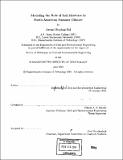| dc.contributor.advisor | Elfaith A.B. Eltahir. | en_US |
| dc.contributor.author | Pal, Jeremy S. (Jeremy Stephan) | en_US |
| dc.contributor.other | Massachusetts Institute of Technology. Dept. of Civil and Environmental Engineering. | en_US |
| dc.date.accessioned | 2005-06-02T15:28:39Z | |
| dc.date.available | 2005-06-02T15:28:39Z | |
| dc.date.copyright | 2001 | en_US |
| dc.date.issued | 2001 | en_US |
| dc.identifier.uri | http://hdl.handle.net/1721.1/17497 | |
| dc.description | Thesis (Ph.D.)--Massachusetts Institute of Technology, Dept. of Civil and Environmental Engineering, 2001. | en_US |
| dc.description | Includes bibliographical references (p. 185-193). | en_US |
| dc.description.abstract | In this thesis, we investigate the physical pathways and mechanisms responsible for shaping the role of soil moisture in North American summer climate using a regional model. To investigate these pathways and mechanisms, we first identify and improve upon some of the deficiencies within the NCAR regional climate model (RegCM), which is used in this study. A new large-scale cloud and precipitation scheme that accounts for the sub-grid variability of clouds is presented and coupled to NCAR RegCM. In addition, a cumulus convective closure that tends to better represent convection in the Great Plains and Midwest is also implemented. Lastly, significant improvements are made to the specification of the initial and boundary conditions of atmospheric and biospheric variables. The combined results show considerable improvements when compared to the old version of the model and display reasonable agreement with observations from satellite and surface station data. Overall, these modifications improve the model's sensitivity, which is critical for both climate change and process studies. A series of numerical experiments are performed to investigate the local pathways relating initial soil moisture to future precipitation using the 1988 drought and 1993 flood as representative events. These experiments show that increases in initial soil moisture over the Midwest result in an increase in rainfall over the same region. The results suggest that local soil moisture conditions played a significant role in maintaining these extreme events. Soil moisture's impact on both the local energy and water budgets proves to be crucial in determining the strength of the soil moisture-rainfall feedback. An additional series of experiments are performed to investigate the remote soil moisture-rainfall pathways. The experiments suggest that an accurate representation of the domain-wide spatial variations in soil moisture is critical to accurately reproduce rainfall. The interannual temporal variations of soil moisture are less important. In addition to the local feedbacks, soil moisture perturbations have a pronounced impact on the large-scale dynamics, which tends to induce a storm track shift that enhances the soil moisture-rainfall feedback. Depending on the region, soil moisture perturbations not only impact the local climate, but also remote climates. | en_US |
| dc.description.statementofresponsibility | by Jeremy Stephan Pal. | en_US |
| dc.format.extent | 193 p. | en_US |
| dc.format.extent | 11494958 bytes | |
| dc.format.extent | 11494765 bytes | |
| dc.format.mimetype | application/pdf | |
| dc.format.mimetype | application/pdf | |
| dc.language.iso | eng | en_US |
| dc.publisher | Massachusetts Institute of Technology | en_US |
| dc.rights | M.I.T. theses are protected by copyright. They may be viewed from this source for any purpose, but reproduction or distribution in any format is prohibited without written permission. See provided URL for inquiries about permission. | en_US |
| dc.rights.uri | http://dspace.mit.edu/handle/1721.1/7582 | |
| dc.subject | Civil and Environmental Engineering. | en_US |
| dc.title | Modeling the role of soil moisture in North American summer climate | en_US |
| dc.type | Thesis | en_US |
| dc.description.degree | Ph.D. | en_US |
| dc.contributor.department | Massachusetts Institute of Technology. Department of Civil and Environmental Engineering | |
| dc.identifier.oclc | 48067620 | en_US |
